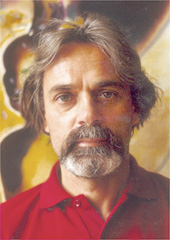 Jörg Remé |
Jörg Remé, artist in the light of UtopiaThe visionary, surrounded by the landscape, concieves a world of his own. He invents and marvels. Like Archimedes, thinking in his bathtub; like Paracelsus, who defied the authority of the metaphysical view of life in his time by stating that he was able to create an artificial man; like Paul Celan, seeing utopia through his speaking grille. Inventions and wonders are due to new, provocative combinations of physics and adventure, not to a humble, metaphysical ostrich posture. And art, as little as other forms of research, is not humble. Because the adventure of artistic creation decides on the utopian space which was waste and bare before, and every step further in that space, says Octavio Paz, is forever irretraceable, forever ineffaceable. The tabou of traditional reality has been breached forever. Life has changed, the world takes on another appearance. It will never be the same as before. In a polemical essay against an art school which was called the 'Philosophical art' (art with a pedagogic, moral or other tendency, and as such in some way subordinated to a 'higher' truth), Baudelaire had stated in the 1860's: 'What is art, according to the modern opinion? It is the creation of a suggestive magic, which includes both the object and the subject, both the world outside the artist and the artist himself.' He views the artist as a magician who bewitches both the things and the self. The act of 'magic' art violates traditional reality, wherein no space is left to the marvelous. Nothing remains as it used to be. The essence of life, the true life, takes ever new forms: the unfitting forms of the stone of wisdom. The art figure, which has fascinated Jörg Remé since 1968 - his self made model, which André Breton would have called the 'inner model' - illustrates that, for him, form and content are two aspects of the same thing. The form is a figuration of flowing, soft, bulging shapes, wrapped in a shining privacy, in an intimate radiance. The content is the marvel, the strangeness, the disarming tenderness and vulnerability. Neither subject nor object have been taken by Remé from the external world. They have been found in an inner reality. They are the model of Remé's research into the essence of things, of feeling and being. Remé's model is a new imaginary human figure, it is like Paracelsus's homunculus an artificial human being. Like all 'real' dolls and animated images, it is not a simplified form taken from nature: there is no question of imitation or naatural representation - which is not to be found in Remé's works, and which apparentiy does not interest him - but it is in the first place a non naturalistic apparition to which, nonetheless, nothing human is alien. The question of the meaning of such an art figure coincides with the question of the function of art itself: it is the meaning and function of the suggestive magic, to use Baudelaire's words, directed towards what is thought to be reality. Art is a 'magic' technique, to make palpable the inner value and meaning of things, landscapes and figures, in a mutating, non imitative way, in order to enter into a dialogue with reality. This research, which has a similarity to alchemy, is a dialogue in which the artist asks the 'from where' and the 'to where' of things, as the poet Paul Celan has called this process; this question is an 'ever open, never ending question, directed toward openness and emptiness and unrestraint'. That is why, says Paul Celan, there is no end to art - and he meant art in the full sense of the word, 'thus also the head of the Medusa, the mechanism, the automaton, the mysterious, so hard to divide and perhaps ultimately single, strangeness.' The strangeness, which is rendered familiar, intimate and fascinating; the strangeness whereto nostalgia is tending; the opposite of estrangement. The inner model of Jörg Remé, a microcosm of feeling, fatamorgana, nostalgia and desire, is mostly set in the dreamlike, irreal landscape of our free time - in paradise - like environments far beyond traffic signs, or in cherished privacies such as a room, a bathtub, a chair, where daydreaming can choose its own forms, protected against the oppressive aesthetic laws of social intercourse. His figures, swelling out of their deepest being, and thus coming to life, embody the fascinating, lovely, inimitable strangeness. They suggest intensely the physical mysteries such as growth, eroticism, procreation. They depict the secret, innate vitality from which ideology and technology tried to estrange the human conciousness. Remé often evokes in his paintings a metaphor between the vegetation, the animal world and the human figures: they are set in the same Utopia. Celan said that art researches things 'in the light of Utopia' - that is the point of convergence to which all signs and images are directed and from where they originate. The magnum opus on which Jörg Remé is working in his art, transmutes matter into the 'gold of time', and creates ineffaceable images of the 'eternally womanlike', of the 'eternally human', of the never ending life force. Laurens Vancrevel |
|